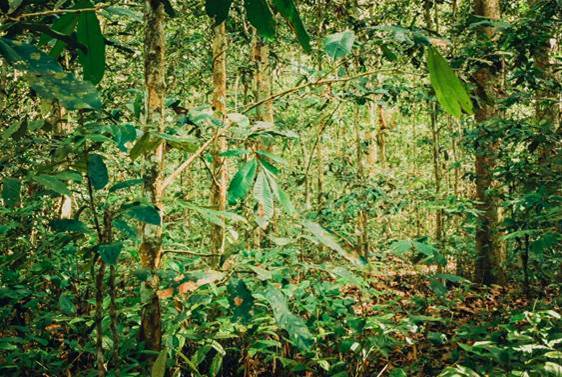|
Getting your Trinity Audio player ready...
|
Nouabalé-Ndoki National Park, Sangha Trinational, Republic of Congo (April 30 2024)—A recent study, published in the scientific journal “Plant Ecology and Evolution,” sheds valuable insights into forest stands of Gilbertiodendron dewevrei (G. dewevrei) in the Sangha Trinational region.
Read this scientific publication HERE.
G. dewevrei, known as “Bemba” or “Limbali” forest by Indigenous Peoples and Local Communities, is a tree species endemic to the Congo Basin that is unusual in forming large stands where it is almost the only species present. The study focuses on the comparative analysis of the structure and composition of this G. dewevrei forest type compared to adjacent forest types. Using data from plot inventories and herbarium specimens, researchers evaluated several parameters, including stem density, basal area, aboveground biomass, stem size class distribution, species diversity, and species composition. The study results revealed significant differences between the two forest types. The G. dewevrei forest has a lower stem density but a higher proportion of large trees, suggesting higher carbon stocks.
Consequently, the findings suggest that the G. dewevrei forest should be considered separately in conservation planning and carbon stock calculations. “This study underscores the importance of recognizing the G. dewevrei forest as a distinct ecosystem in our conservation and natural resource management efforts. By gaining a deeper understanding of the characteristics of this forest, we can enhance our ability to protect it and contribute to biodiversity conservation,” said Richard Malonga, Country Director of WCS Congo.
Led by Ellen Heimpel, and David J. Harris, this research was conducted by the Royal Botanic Garden of Edinburgh in collaboration with WCS Congo, with support from the Ministry of Forestry Economy, the Ministry of Scientific Research and Technological Innovation of the Government of Congo, as well as the Congolese Agency for Wildlife and Protected Areas (ACFAP).
“In this paper, we show that Gilbertiodendron dewevrei forest is distinct from mixed forest in both species composition and forest structure. It contains a unique community of plant life and may store more carbon than other mixed-species forests. We believe that this is an important forest type to conserve,” noted Ellen Heimpel, a PhD student at the Royal Botanic Garden Edinburgh. Dr David J. Harris added, “Limbali forest is widespread across the northern Republic of Congo, southern Central African Republic, parts of Cameroon and DRC. The more we understand about this forest, the better we can make sure its value can be reflected in policies on forests in the Congo Basin.”
Future research steps will include a deeper exploration of the factors influencing species associations within the G. dewevrei forest, as well as comparisons with other regions where this species is present. Mapping the extent of G. dewevrei forests in the Congo Basin is also a priority for effective conservation planning.
About Wildlife Conservation Society
WCS combines the power of its zoos and an aquarium in New York City and a Global Conservation Program in more than 50 countries to achieve its mission to save wildlife and wild places. WCS runs the world’s largest conservation field program, protecting more than 50 percent of Earth’s known biodiversity; in partnership with governments, Indigenous People, Local Communities, and the private sector. Its four zoos and aquarium (the Bronx Zoo, Central Park Zoo, Queens Zoo, Prospect Park Zoo, and the New York Aquarium) welcome more than 3.5 million visitors each year, inspiring generations to care for nature. Visit: newsroom.wcs.org. Follow: @WCSNewsroom. For more information: +1 (347) 840-1242. Listen to the WCS Wild Audio podcast HERE.
About WCS Congo
For more than 30 years, WCS has played a major role in the conservation of wildlife and wild places in the Republic of Congo, where it has contributed to the creation, expansion, and management of three of the five national parks. WCS works closely with the government, national stakeholders, and local communities to protect Congo’s rich ecosystems.
About Nouabalé-Ndoki National Park
Nouabalé-Ndoki National Park is arguably the best remaining example of an intact ecosystem in the Congo Basin. It covers more than 4,100 km2 of lowland rainforest and is home to critical populations of endangered mammals, such as forest elephants, lowland gorillas and chimpanzees. Nouabalé-Ndoki was listed as the Congolese sector of the Sangha Trinational, as a World Heritage Site in 2012, and as a Key Biodiversity area in 2024.






